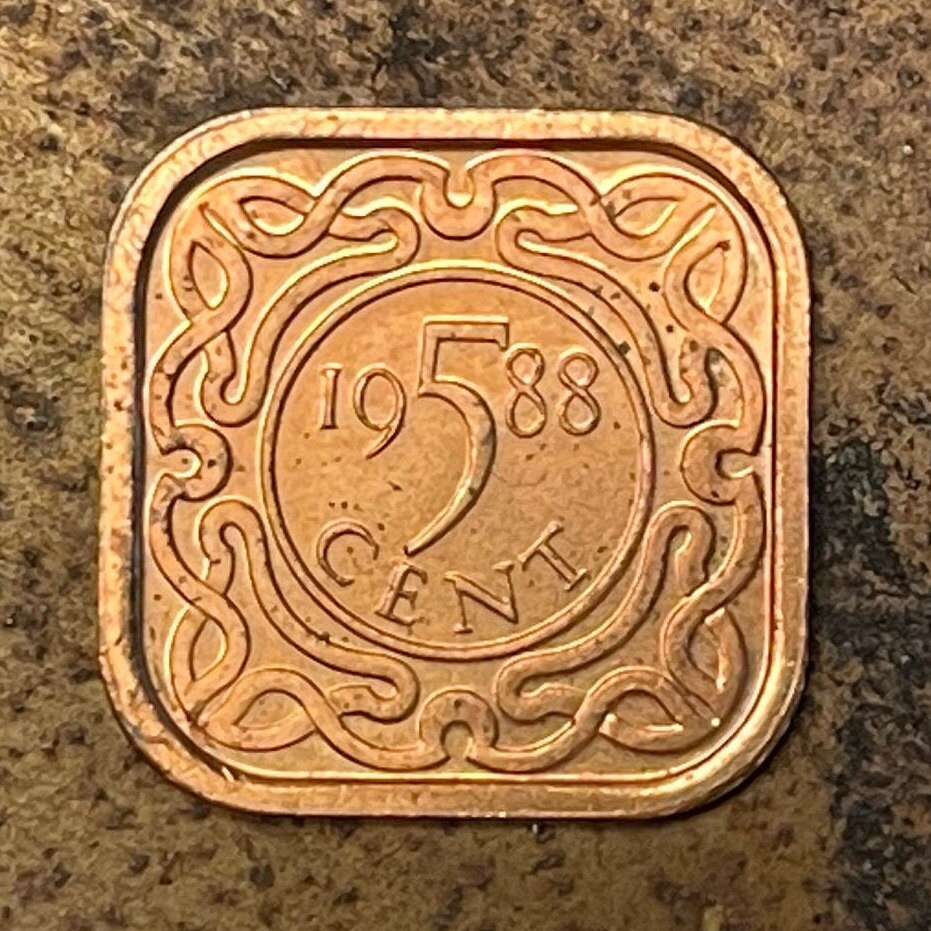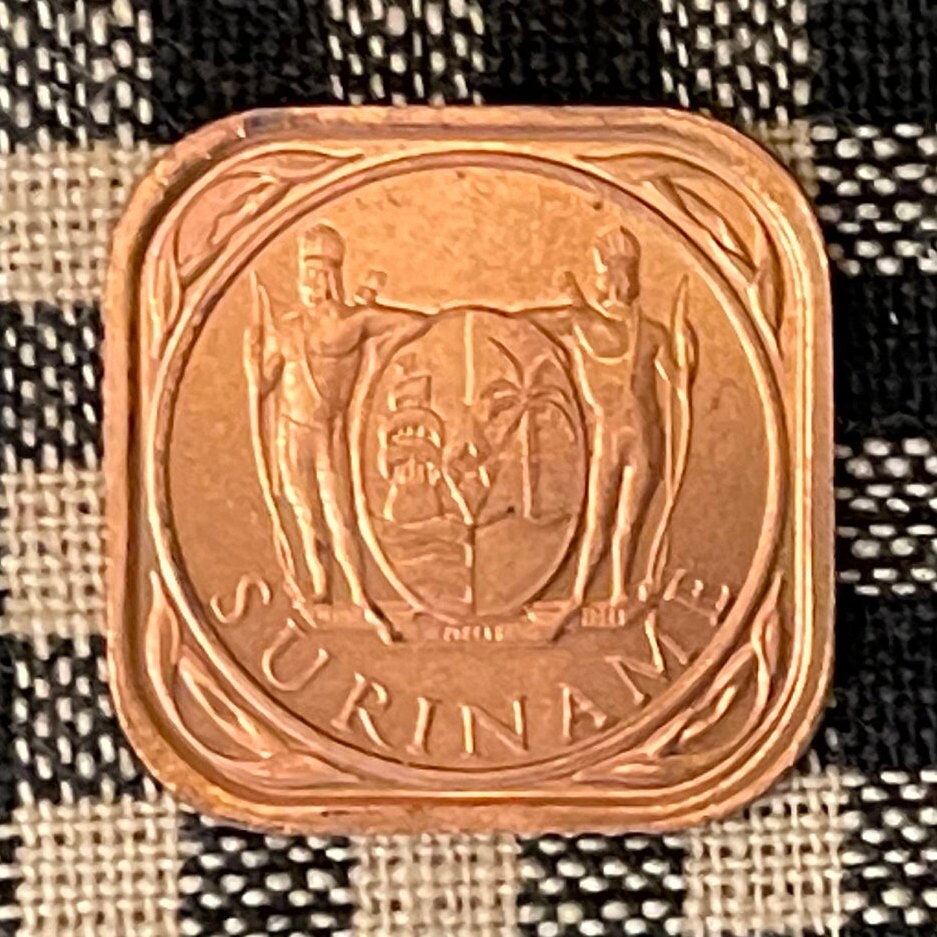elemintalshop
Colonial Trade Ship, Arawak Indigenous Men, Royal Palm 5 Cents Suriname Authentic Square Coin Money for Jewelry (Colonialism)
Colonial Trade Ship, Arawak Indigenous Men, Royal Palm 5 Cents Suriname Authentic Square Coin Money for Jewelry (Colonialism)
Couldn't load pickup availability
Colonial Trade Ship, Arawak Indigenous Men, Royal Palm 5 Cents Suriname Authentic Square Coin Money for Jewelry (Colonialism)
Obverse: Coat of arms of Suriname.
Two indigenous Arawak men carrying a shield that shows a trade ship on the water, a royal palm, and a star in a diamond.
The whole surrounded by a circle.
Lettering: SURINAME
Reverse
Denomination divides year. The whole surrounded by a circle and a wreath.
Features
Issuer Suriname
Period Republic (1975-date)
Type Standard circulation coin
Years 1987-2017
Value 5 Cents (0.05 SRG)
Currency Guilder (1826-2003)
Composition Copper plated steel
Weight 3 g
Diameter 22 mm
Thickness 1.51 mm
Shape Square with rounded corners
Orientation Coin alignment ↑↓
Number N# 6047
References KM# 12.1b
Wikipedia:
The coat of arms of Suriname was adopted on November 25, 1975. The motto reads Justitia – Pietas – Fides (“Justice – Piety – Fidelity”). It consists of two indigenous men carrying a shield; a trade ship on the water representing Suriname's colonial past as a source of cash crops and its present day involvement in international commerce; the royal palm represents both the rainforest that covers two-thirds of the country and the country's involvement in agribusiness; the diamond represents the mining industry; the star symbolizes the five continents from which the inhabitants of Suriname immigrated.
*********
The early history of Suriname dates from 3000 BCE when Native Americans first inhabited the area. The Dutch acquired Suriname from the English, and European settlement in any numbers dates from the seventeenth century, when it was a plantation colony utilizing slavery for sugar cultivation. With abolition in the late nineteenth century, planters sought labor from China, Madeira, India, and Indonesia, which was also colonized by the Dutch. Dutch is Suriname's official language. Owing to its diverse population, it has also developed a creole language, Sranan.
....In South America, slavery was the norm. The native people proved to be in limited supply and consequently the Atlantic slave trade supplied the workforce for the plantations. The plantations were producing sugar, coffee, cocoa, cotton which were exported for the Amsterdam market. In 1713 for instance most of the work on the 200 plantations was done by 13,000 African slaves. Their treatment was horrific, and slaves periodically escaped to the jungle from the start. These Maroons (also known as "Djukas" or "Bakabusi Nengre") attacked the plantations in order to acquire goods that were in short supply and to free enslaved women. Notable leaders of the Surinam Maroons were Alabi, Boni, Joli-coeur and Broos (Captain Broos). In the 18th century, three of the Maroon people signed a peace treaty, similar to the peace treaty ending the First Maroon War in Jamaica, whereby they were recognised as free people and received a yearly tribute that provided them with the goods they used to "liberate" from the plantations. A contemporary description of the war between the Maroons and the plantation owners in Suriname can be found in Narrative of a Five Years Expedition Against the Revolted Negroes of Surinam by John Gabriel Stedman.
Suriname was occupied by the British in 1799, after the Netherlands were incorporated by France, and was returned to the Dutch in 1816, after the defeat of Napoleon. The Dutch abolished slavery only in 1863, although the British had already abolished it during their short rule. The freed slaves were, however, still required to continue their plantation work on a contract basis and were not released until 1873; up to that date they conducted obligatory but paid work at the plantations. In the meantime, many more workers had been imported from the Dutch East Indies, mostly Chinese inhabitants of that colony, creating a Chinese Surinamese population. From 1873 to 1916, many laborers were imported from India, creating the Indo-Surinamese. After 1916, many laborers were again imported from the Dutch East Indies, especially Java, creating the Javanese Surinamese....
********
Wikipedia:
Roystonea regia, commonly known as the Cuban royal palm or Florida royal palm, is a species of palm that is native to Mexico, parts of Central America and the Caribbean, and southern Florida. A large and attractive palm, it has been planted throughout the tropics and subtropics as an ornamental tree. Although it is sometimes called R. elata, the conserved name R. regia is now the correct name for the species. The royal palm reaches heights from 50 to over 80 feet tall. Populations in Cuba and Florida were long seen as separate species, but are now considered to belong to a single species.
Best known as an ornamental, R. regia is also used as a source of thatch, construction timber, and in some forms of so-called traditional medicine, although there is currently no valid scientific evidence to support the efficacy or use of any palm species for medicinal purposes. The fruit is eaten by birds and bats (which disperse the seeds) and fed to livestock. Its flowers are visited by birds and bats, and it serves as a roosting site and food source for a variety of animals. Roystonea regia is the national tree of Cuba, and has a religious role both in Santería and Christianity, where it is used in Palm Sunday observances.
Share










Excellent coin. Looks great in my collection
5 stars review from Shannon
5 stars review from Cynthia









